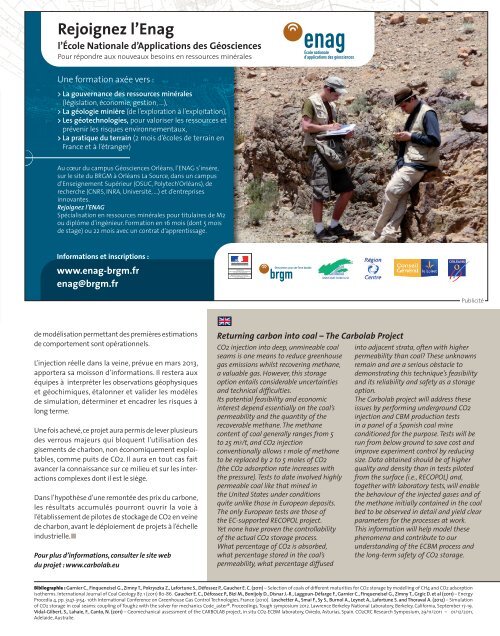revue_geosciences16
revue_geosciences16
revue_geosciences16
You also want an ePaper? Increase the reach of your titles
YUMPU automatically turns print PDFs into web optimized ePapers that Google loves.
Rejoignez l’Enag<br />
returning carbon into coal – the carbolab project<br />
l’École Nationale d’Applications des Géosciences<br />
Pour répondre aux nouveaux besoins en ressources minérales<br />
Une formation axée vers :<br />
> La gouvernance des ressources minérales<br />
(législation, économie, gestion, …),<br />
> La géologie minière (de l’exploration à l’exploitation),<br />
> Les géotechnologies, pour valoriser les ressources et<br />
prévenir les risques environnementaux,<br />
> La pratique du terrain (2 mois d’écoles de terrain en<br />
France et à l’étranger)<br />
Au cœur du campus Géosciences Orléans, l’ENAG s’insère,<br />
sur le site du BRGM à Orléans La Source, dans un campus<br />
d’Enseignement Supérieur (OSUC, Polytech’Orléans), de<br />
recherche (CNRS, INRA, Université, …) et d’entreprises<br />
innovantes.<br />
Rejoignez l’ENAG<br />
Spécialisation en ressources minérales pour titulaires de M2<br />
ou diplôme d’ingénieur. Formation en 16 mois (dont 5 mois<br />
de stage) ou 22 mois avec un contrat d’apprentissage.<br />
Informations et inscriptions :<br />
www.enag-brgm.fr<br />
enag@brgm.fr<br />
de modélisation permettant des premières estimations<br />
de comportement sont opérationnels.<br />
L’injection réelle dans la veine, prévue en mars 2013,<br />
apportera sa moisson d’informations. Il restera aux<br />
équipes à interpréter les observations géophysiques<br />
et géochimiques, étalonner et valider les modèles<br />
de simulation, déterminer et encadrer les risques à<br />
long terme.<br />
Une fois achevé, ce projet aura permis de lever plusieurs<br />
des verrous majeurs qui bloquent l’utilisation des<br />
gisements de charbon, non économiquement exploitables,<br />
comme puits de CO2. Il aura en tout cas fait<br />
avancer la connaissance sur ce milieu et sur les interactions<br />
complexes dont il est le siège.<br />
Dans l’hypothèse d’une remontée des prix du carbone,<br />
les résultats accumulés pourront ouvrir la voie à<br />
l’établissement de pilotes de stockage de CO2 en veine<br />
de charbon, avant le déploiement de projets à l’échelle<br />
industrielle.ó<br />
Pour plus d’informations, consulter le site web<br />
du projet : www.carbolab.eu<br />
Returning carbon into coal – The Carbolab Project<br />
CO2 injection into deep, unmineable coal<br />
seams is one means to reduce greenhouse<br />
gas emissions whilst recovering methane,<br />
a valuable gas. However, this storage<br />
option entails considerable uncertainties<br />
and technical difficulties.<br />
Its potential feasibility and economic<br />
interest depend essentially on the coal’s<br />
permeability and the quantity of the<br />
recoverable methane. The methane<br />
content of coal generally ranges from 5<br />
to 25 m 3/t, and CO2 injection<br />
conventionally allows 1 mole of methane<br />
to be replaced by 2 to 5 moles of CO2<br />
(the CO2 adsorption rate increases with<br />
the pressure). Tests to date involved highly<br />
permeable coal like that mined in<br />
the United States under conditions<br />
quite unlike those in European deposits.<br />
The only European tests are those of<br />
the EC-supported RECOPOL project.<br />
Yet none have proven the controllability<br />
of the actual CO2 storage process.<br />
What percentage of CO2 is absorbed,<br />
what percentage stored in the coal’s<br />
permeability, what percentage diffused<br />
into adjacent strata, often with higher<br />
permeability than coal? These unknowns<br />
remain and are a serious obstacle to<br />
demonstrating this technique’s feasibility<br />
and its reliability and safety as a storage<br />
option.<br />
The Carbolab project will address these<br />
issues by performing underground CO2<br />
injection and CBM production tests<br />
in a panel of a Spanish coal mine<br />
conditioned for the purpose. Tests will be<br />
run from below ground to save cost and<br />
improve experiment control by reducing<br />
size. Data obtained should be of higher<br />
quality and density than in tests piloted<br />
from the surface (i.e., RECOPOL) and,<br />
together with laboratory tests, will enable<br />
the behaviour of the injected gases and of<br />
the methane initially contained in the coal<br />
bed to be observed in detail and yield clear<br />
parameters for the processes at work.<br />
This information will help model these<br />
phenomena and contribute to our<br />
understanding of the ECBM process and<br />
the long-term safety of CO2 storage.<br />
Bibliographie : Garnier C., Finqueneisel G., Zimny T., Pokryszka Z., Lafortune S., Défossez P., Gaucher E. C. (2011) – Selection of coals of different maturities for CO2 storage by modelling of CH4 and CO2 adsorption<br />
isotherms. International Journal of Coal Geology 87, 1 (2011) 80-86. Gaucher E. C., Défossez P., Bizi M., Bonijoly D., Disnar J.-R., Laggoun-Défarge F., Garnier C., Finqueneisel G., Zimny T., Grgic D. et al (2011) – Energy<br />
Procedia 4, pp. 3147-3154- 10th International Conference on Greenhouse Gas Control Technologies, France (2010). Loschetter A., Smai F., Sy S., Burnol A., Leynet A., Lafortune S. and Thoraval A. (2012) – Simulation<br />
of CO2 storage in coal seams: coupling of Tough2 with the solver for mechanics Code_aster®. Proceedings, Tough symposium 2012. Lawrence Berkeley National Laboratory, Berkeley, California, September 17-19.<br />
Vidal-Gilbert, S., Lahaie, F., Canto, N. (2011) – Geomechanical assessment of the CARBOLAB project, in situ CO2-ECBM laboratory, Oviedo, Asturias, Spain. CO2CRC Research Symposium, 29/11/2011 – 01/12/2011,<br />
Adelaide, Australie.<br />
Publicité












